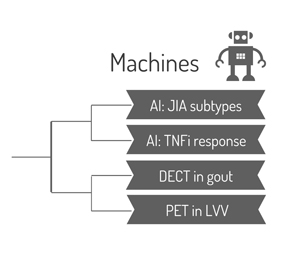 Editor’s note: RheumMadness is the place for everyone crazy about rheumatology to connect, collaborate, compete and learn together. During RheumMadness, rheumatology concepts represent teams that compete against each other in a tournament, much like basketball teams do in the NCAA’s March Madness tournament. In a series for The Rheumatologist, readers will get a chance to read the scouting reports for each concept team. These reports are written by rheumatology fellows from 13 programs throughout the U.S.
Editor’s note: RheumMadness is the place for everyone crazy about rheumatology to connect, collaborate, compete and learn together. During RheumMadness, rheumatology concepts represent teams that compete against each other in a tournament, much like basketball teams do in the NCAA’s March Madness tournament. In a series for The Rheumatologist, readers will get a chance to read the scouting reports for each concept team. These reports are written by rheumatology fellows from 13 programs throughout the U.S.
Don’t forget to submit your RheumMadness 2022 bracket by March 25. The more your picks match those of our Blue Ribbon Panel of rheumatologists, the more points you get. Learn more about the panel and how the brackets work online.
Connect with RheumMadness by subscribing to the podcast and joining the conversation on Twitter, #RheumMadness. Learn more on the RheumMadness website.
Region: Machines Team: AI: JIA Subtypes
Juvenile idiopathic arthritis (JIA) is the most common pediatric rheumatologic condition, affecting up to 300,000 children in the U.S., in total. Although in adult medicine our colleagues take care of patients under the single diagnosis of rheumatoid arthritis (RA), here in pediatrics we like to complicate things. The current pediatric classification criteria—the 1995 International League of Association of Rheumatology (ILAR) criteria—include seven different subtypes of JIA, namely oligoarticular JIA, rheumatoid factor (RF) positive polyarticular JIA, RF-negative polyarticular JIA, systemic JIA, enthesitis-related JIA, psoriatic JIA and undifferentiated JIA.
 As we learn more about genetic profiles and immune signatures, the discussion regarding the accuracy of these subtypes has evolved. These discussions have challenged how we stratify our patients’ risk, think about their prognosis and decide on treatment plans.
As we learn more about genetic profiles and immune signatures, the discussion regarding the accuracy of these subtypes has evolved. These discussions have challenged how we stratify our patients’ risk, think about their prognosis and decide on treatment plans.
Machine learning is a potential tool to help distinguish different JIA subtypes and predict treatment response. It’s a unique approach to help make predictions and classification more efficient through the use of big data analysis, similar to how your phone or Instagram account predicts what you want to buy without you even whispering it.
In this single-center, proof-of-concept study, 85 patients with JIA and 43 age-matched controls were immune-profiled via flow cytometry and machine learning.1 This study used multiple machine learning methods, including methods that sound like they’re straight out of a science fiction novel, such as artificial neural networks. Subtypes of JIA were compared and contrasted using four distinct categorizing systems:
- The ILAR criteria subtype;
- RF-positive polyarticular and systemic JIA vs. RF-negative “polygo” JIA, including RF-negative polyarthritis JIA, extended oligoarthritis JIA and persistent oligoarthritis JIA;
- Combined polyarticular and extended oligoarticular JIA vs. persistent oligoarticular JIA vs. systemic JIA; and
- Systemic JIA vs. non-systemic anti-nuclear antibodies (ANA) positive JIA vs. non-systemic ANA negative JIA.
Next, patients were classified as having active or inactive disease using the Wallace criteria. Ultimately, the most consistent finding was that systemic JIA stood out as having a distinct and unique immune signature when compared with any other groups.



